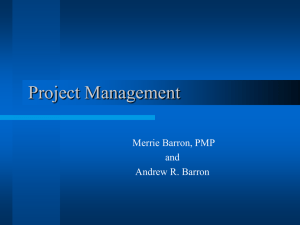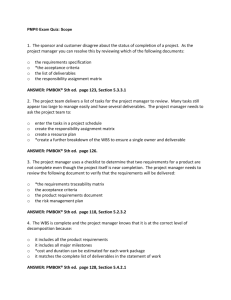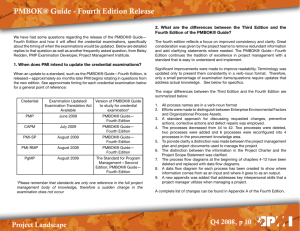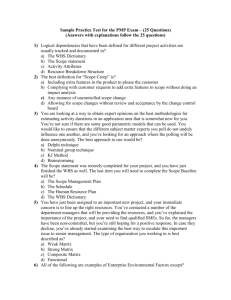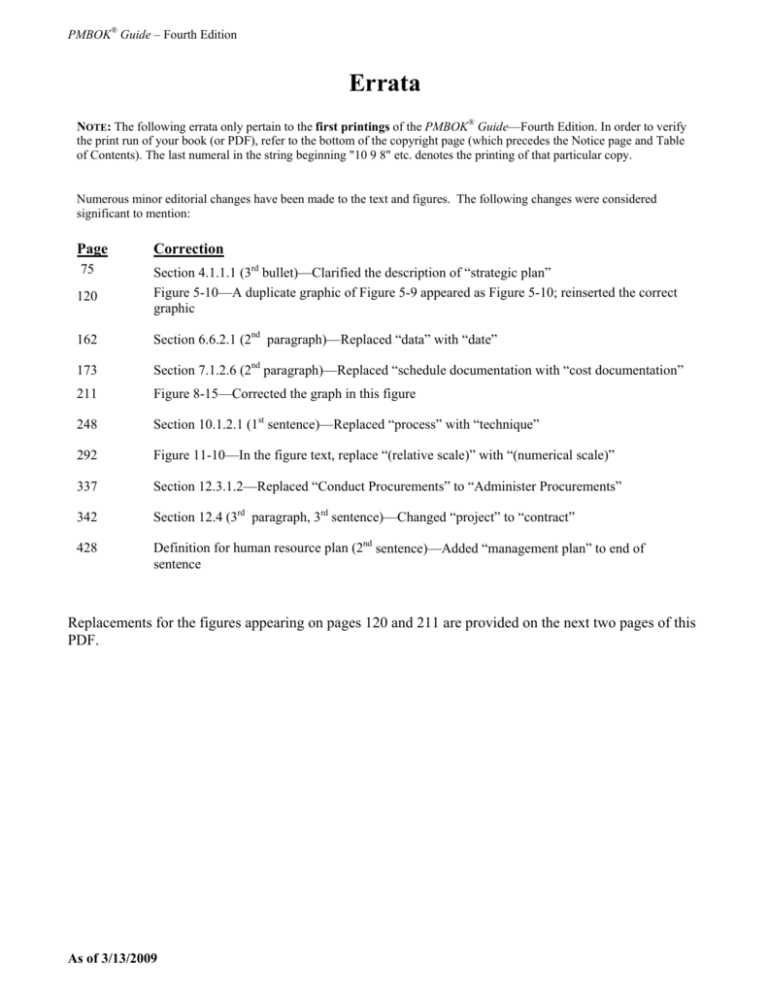
PMBOK® Guide – Fourth Edition
Errata
NOTE: The following errata only pertain to the first printings of the PMBOK® Guide—Fourth Edition. In order to verify
the print run of your book (or PDF), refer to the bottom of the copyright page (which precedes the Notice page and Table
of Contents). The last numeral in the string beginning "10 9 8" etc. denotes the printing of that particular copy.
Numerous minor editorial changes have been made to the text and figures. The following changes were considered
significant to mention:
Page
Correction
75
Section 4.1.1.1 (3rd bullet)—Clarified the description of “strategic plan”
Figure 5-10—A duplicate graphic of Figure 5-9 appeared as Figure 5-10; reinserted the correct
graphic
120
162
Section 6.6.2.1 (2nd paragraph)—Replaced “data” with “date”
173
Section 7.1.2.6 (2nd paragraph)—Replaced “schedule documentation with “cost documentation”
211
Figure 8-15—Corrected the graph in this figure
248
Section 10.1.2.1 (1st sentence)—Replaced “process” with “technique”
292
Figure 11-10—In the figure text, replace “(relative scale)” with “(numerical scale)”
337
Section 12.3.1.2—Replaced “Conduct Procurements” to “Administer Procurements”
342
Section 12.4 (3rd paragraph, 3rd sentence)—Changed “project” to “contract”
428
Definition for human resource plan (2nd sentence)—Added “management plan” to end of
sentence
Replacements for the figures appearing on pages 120 and 211 are provided on the next two pages of this
PDF.
As of 3/13/2009
CHAPTER 4 − PROJECT INTEGRATION MANAGEMENT
4
4.1.1 Develop Project Charter: Inputs
.1 Project Statement of Work
The statement of work (SOW) is a narrative description of products or services to be delivered by
the project. For internal projects, the project initiator or sponsor provides the statement of work based
on business needs, product, or service requirements. For external projects, the statement of work can
be received from the customer as part of a bid document, for example, request for proposal, request
for information, request for bid, or as part of a contract. The SOW references:
• Business need. An organization’s business need may be based on a market demand, technological
advance, legal requirement, or government regulation.
• Product scope description. This documents the characteristics of the product that the project
will be undertaken to create. The description should also document the relationship between the
products or services being created and the business need that the project will address.
• Strategic plan. The strategic plan documents the organization’s strategic goals. Therefore, all
projects should be aligned with the strategic plan.
.2 Business Case
The business case or similar document provides the necessary information from a business
standpoint to determine whether or not the project is worth the required investment. Typically the
business need and the cost-benefit analysis are contained in the business case to justify the project.
The requesting organization or customer, in the case of external projects, may write the business case.
The business case is created as a result of one or more of the following:
• Market demand (e.g., a car company authorizing a project to build more fuel-efficient cars in
response to gasoline shortages),
• Organizational need (e.g., a training company authorizing a project to create a new course to
increase its revenues),
• Customer request (e.g., an electric utility authorizing a project to build a new substation to serve
a new industrial park),
• Technological advance (e.g., an electronics firm authorizing a new project to develop a faster,
cheaper, and smaller laptop after advances in computer memory and electronics technology),
• Legal requirement (e.g., a paint manufacturer authorizing a project to establish guidelines for
handling toxic materials),
©2008 Project Management Institute. A Guide to the Project Management Body of Knowledge (PMBOK® Guide) — Fourth Edition
75
17758_066-102-R1.indd 75
5/4/09 2:48:12 AM
5
CHAPTER 5 − PRojECT SCoPE MAnAgEMEnT
Aircraft
System
Project
Management
Training
Data
Air
Vehicle
Support
Equipment
Facilities
Test and
Evaluation
System
Engineering
Management
Equipment
Training
Technical
Orders
Organizational
Level SE
Base
Buildings
Mock-ups
Supporting
PM Activities
Facilities
Training
Engineering
Data
Intermediate
Level SE
Maintenance
Facility
Operational
Test
Services
Training
Management
Data
Depot
Level SE
Developmental
Test
Test
Airframe
Engine
Communication
System
Navigation
System
Fire Control
System
The WBS is illustrative only. It is not intended to represent the full project scope of any specific project,
nor to imply that this is the only way to organize a WBS on this type of project.
Figure 5-10. Sample Work Breakdown with Major Deliverables
A Guide to the Project Management Body of Knowledge (PMBOK® Guide) – Fourth Edition. ©2008 Project Management Institute, Inc. All Rights Reserved.
Figure 5-10. Sample Work Breakdown with Major Deliverables
Decomposition of the upper level WBS components requires subdividing the work for each of the
deliverables or subprojects into its fundamental components, where the WBS components represent
verifiable products, services, or results. The WBS can be structured as an outline, an organizational
chart, a fishbone diagram, or other method. Verifying the correctness of the decomposition requires
determining that the lower-level WBS components are those that are necessary and sufficient for
completion of the corresponding higher level deliverables. Different deliverables can have different
levels of decomposition. To arrive at a work package, the work for some deliverables needs to be
decomposed only to the next level, while others need additional levels of decomposition. As the work
is decomposed to greater levels of detail, the ability to plan, manage, and control the work is enhanced.
However, excessive decomposition can lead to non-productive management effort, inefficient use of
resources, and decreased efficiency in performing the work.
Decomposition may not be possible for a deliverable or subproject that will be accomplished far
into the future. The project management team usually waits until the deliverable or subproject is
clarified so the details of the WBS can be developed. This technique is sometimes referred to as rolling
wave planning.
A Guide to the Project Management Body of Knowledge (PMBOK® Guide) — Fourth Edition
©2008 Project Management Institute, 14 Campus Blvd., Newtown Square, PA 19073-3299 USA
120
8
CHAPTER 8 − PRojECT QuAliTy MAnAgEMEnT
Pareto diagrams are conceptually related to Pareto’s Law, which holds that a relatively small number
of causes will typically produce a majority of the problems or defects. This is commonly referred to as
the 80/20 principle, where 80% of the problems are due to 20% of the causes. Pareto diagrams can
also be used to summarize various types of data for 80/20 analyses.
Pareto Diagram of Causes of Late Time Entries
40
100%
35
90%
Rate of Defects
70%
25
60%
20
50%
15
40%
30%
10
20%
5
0
Frequency
Cumulative
Percent of Defects
80%
30
10%
Process
Instructions
30
30%
Insufficient
Time
25
55%
Travel
15
70%
System
Failure
11
81%
Management
Direction
5
86%
0%
Other
14
100%
Occurrences
Figure 8-15. Pareto Diagram
Figure 8-15. Pareto Diagram
A Guide to the Project Management Body of Knowledge (PMBOK® Guide) – Fourth Edition. ©2008 Project Management Institute, Inc. All Rights Reserved.
.6 Run Chart
Similar to a control chart without displayed limits, a run chart shows the history and pattern of
variation. A run chart is a line graph that shows data points plotted in the order in which they occur.
Run charts show trends in a process over time, variation over time, or declines or improvements in a
process over time. Trend analysis is performed using run charts and involves mathematical techniques
to forecast future outcomes based on historical results. Trend analysis is often used to monitor:
A Guide to the Project Management Body of Knowledge (PMBOK® Guide) — Fourth Edition
©2008 Project Management Institute, 14 Campus Blvd., Newtown Square, PA 19073-3299 USA
211

